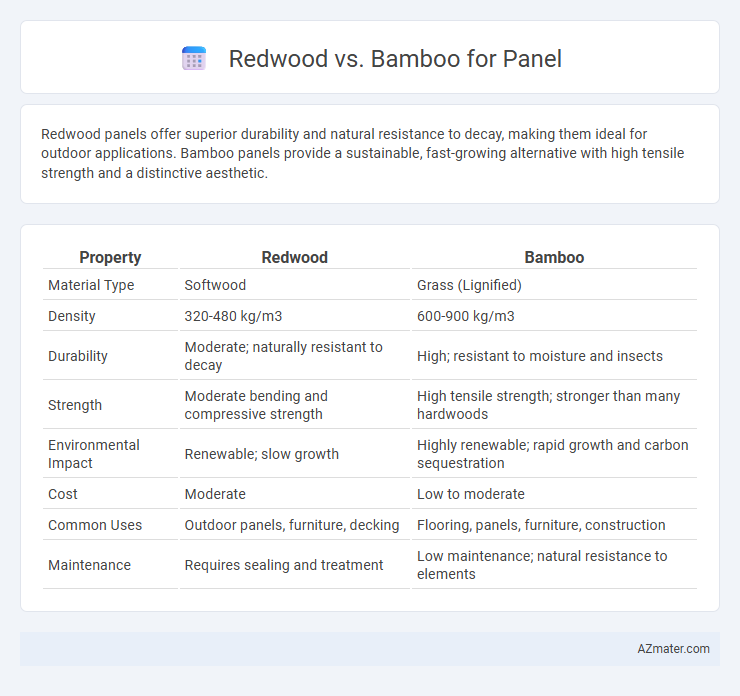Redwood panels offer superior durability and natural resistance to decay, making them ideal for outdoor applications. Bamboo panels provide a sustainable, fast-growing alternative with high tensile strength and a distinctive aesthetic.
Table of Comparison
| Property | Redwood | Bamboo |
|---|---|---|
| Material Type | Softwood | Grass (Lignified) |
| Density | 320-480 kg/m3 | 600-900 kg/m3 |
| Durability | Moderate; naturally resistant to decay | High; resistant to moisture and insects |
| Strength | Moderate bending and compressive strength | High tensile strength; stronger than many hardwoods |
| Environmental Impact | Renewable; slow growth | Highly renewable; rapid growth and carbon sequestration |
| Cost | Moderate | Low to moderate |
| Common Uses | Outdoor panels, furniture, decking | Flooring, panels, furniture, construction |
| Maintenance | Requires sealing and treatment | Low maintenance; natural resistance to elements |
Introduction to Redwood and Bamboo Panels
Redwood panels offer natural resistance to decay and insects, making them ideal for outdoor applications such as siding and fencing, with a distinctive reddish hue and tight grain structure that enhances durability. Bamboo panels, derived from fast-growing bamboo grass, provide a sustainable and eco-friendly alternative, valued for their strength, flexibility, and unique linear grain patterns that add a modern aesthetic. Both materials present versatile solutions for paneling needs, with redwood emphasizing longevity and natural beauty, while bamboo prioritizes sustainability and contemporary design.
Material Properties: Redwood vs Bamboo
Redwood offers exceptional durability with natural resistance to decay and insects, featuring a fine grain and stable dimensional properties ideal for outdoor panels. Bamboo exhibits rapid growth and impressive tensile strength, characterized by its lightweight, flexibility, and eco-friendliness, making it suitable for sustainable paneling solutions. Both materials vary in hardness, moisture resistance, and maintenance requirements, influencing their performance and longevity in different environmental conditions.
Sustainability and Environmental Impact
Redwood panels offer exceptional sustainability due to their natural resistance to decay, requiring less chemical treatment and extending the product's lifespan, which reduces environmental impact. Bamboo panels, as a rapidly renewable resource, grow much faster than traditional hardwoods, significantly lowering carbon footprint and promoting sustainable forestry practices. Both materials contribute to eco-friendly construction, but bamboo's swift replenishment cycles enhance its appeal for green building projects prioritizing environmental conservation.
Durability and Longevity Comparison
Redwood panels offer exceptional durability due to natural resistance against decay and insect damage, making them ideal for long-lasting outdoor applications. Bamboo panels, while sustainable and rapidly renewable, typically require treatment to enhance durability and resist moisture and pests effectively. Over time, redwood generally outperforms bamboo in longevity, often lasting several decades with minimal maintenance compared to treated bamboo's shorter lifespan.
Aesthetic Appeal and Design Versatility
Redwood offers rich, warm tones and a fine grain that enhances panel aesthetics with a classic, luxurious look ideal for traditional and rustic designs. Bamboo provides a modern, sleek appearance with its uniform texture and natural variations, supporting innovative and contemporary panel styles. Both materials deliver high design versatility, but bamboo's rapid renewability and customization options make it a preferred choice for eco-conscious, dynamic interior projects.
Installation and Maintenance Requirements
Redwood panels require precise installation with stainless steel fasteners to prevent corrosion, maintaining their natural resistance to decay and insects, while they benefit from periodic sealing to preserve color and prevent weathering. Bamboo panels, often manufactured as engineered products, generally demand careful pre-installation acclimatization to reduce expansion and contraction issues, with maintenance emphasizing regular cleaning and occasional resealing to sustain durability and aesthetics. Both materials offer distinct installation and maintenance protocols, with redwood favoring natural resilience and bamboo requiring more controlled conditions for longevity.
Cost Analysis: Redwood vs Bamboo Panels
Redwood panels typically cost between $8 to $12 per square foot, reflecting their natural durability and aesthetic appeal, while bamboo panels range from $6 to $10 per square foot, offering a more affordable but equally sustainable alternative. Bamboo's rapid renewability often results in lower long-term expenses compared to redwood, which requires more extensive harvesting and processing. When budgeting for panel installations, considering not only upfront costs but also maintenance and longevity can highlight bamboo as the cost-effective choice without compromising on strength or visual quality.
Common Applications and Use Cases
Redwood panels are commonly used in outdoor construction projects such as decking, siding, and fencing due to their natural resistance to moisture, decay, and insects. Bamboo panels are favored for interior applications like flooring, wall coverings, and furniture because of their rapid growth, sustainability, and high tensile strength. Both materials are popular in eco-friendly building and design, with redwood ideal for weather-exposed environments and bamboo suited for durable indoor surfaces.
Pros and Cons of Redwood Panels
Redwood panels offer superior durability and natural resistance to moisture, decay, and insect damage, making them ideal for outdoor applications. Their rich, warm color and fine grain provide an attractive aesthetic, but they tend to be more expensive and require regular maintenance to preserve their appearance. Redwood is softer than bamboo, which can lead to denting and scratching more easily in high-traffic areas or heavy use environments.
Pros and Cons of Bamboo Panels
Bamboo panels offer exceptional sustainability due to rapid growth rates and renewable harvesting, making them an eco-friendly alternative to traditional wood. Their natural resistance to moisture and insects reduces maintenance needs, but they can be prone to cracking or warping under extreme weather conditions without proper treatment. While bamboo panels provide a modern aesthetic with a lightweight structure, they may lack the long-term durability and aging grace of redwood panels.

Infographic: Redwood vs Bamboo for Panel
 azmater.com
azmater.com